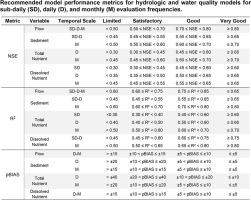Establishing performance criteria for evaluating watershed-scale sediment and nutrient models at fine temporal scales
IF 11.4
1区 环境科学与生态学
Q1 ENGINEERING, ENVIRONMENTAL
引用次数: 0
Abstract
Watershed water quality models are mathematical tools used to simulate processes related to water, sediment, and nutrients. These models provide a framework that can be used to inform decision-making and the allocation of resources for watershed management. Therefore, it is critical to answer the question “when is a model good enough?” Established performance evaluation criteria, or thresholds for what is considered a ‘good’ model, provide common benchmarks against which model performance can be compared. Since the publication of prior meta-analyses on this topic, developments in the last decade necessitate further investigation, such as the advancement in high performance computing, the proliferation of aquatic sensors, and the development of machine learning algorithms. We surveyed the literature for quantitative model performance measures, including the Nash-Sutcliffe efficiency (NSE), with a particular focus on process-based models operating at fine temporal scales as their performance evaluation criteria are presently underdeveloped. The synthesis dataset was used to assess the influence of temporal resolution (sub-daily, daily, and monthly), calibration duration (< 3 years, 3 to 8 years, and > 8 years), and constituent target units (concentration, load, and yield) on model performance. The synthesis dataset includes 229 model applications, from which we use bootstrapping and personal modeling experience to establish sub-daily and daily performance evaluation criteria for flow, sediment, total nutrient, and dissolved nutrient models. For daily model evaluation, the NSE for sediment, total nutrient, and dissolved nutrient models should exceed 0.45, 0.30, and 0.35, respectively, for ‘satisfactory’ performance. Model performance generally improved when transitioning from short (< 3 years) to medium (3 to 8 years) calibration durations, but no additional gain was observed with longer (> 8 years) calibration. Dissolved nutrient models calibrated to load (e.g., kg/s) out-performed those calibrated to concentration (e.g., mg/L), whereas selection of target units was not significant for sediment and total nutrient models. We recommend the use of concentration rather than load as a water quality modeling target, as load may be biased by strong flow model performance whereas concentration provides a flow-independent measure of performance. Although the performance criteria developed herein are based on process-based models, they may be useful in assessing machine learning model performance. We demonstrate one such assessment on a recent deep learning model of daily nitrate prediction across the United States. The guidance presented here is intended to be used alongside, rather than to replace, the experience and modeling judgement of engineers and scientist who work to maintain our collective water resources.


建立在精细时间尺度上评价流域泥沙和养分模型的性能标准
流域水质模型是用来模拟与水、沉积物和营养物质有关的过程的数学工具。这些模型提供了一个框架,可用于为流域管理的决策和资源分配提供信息。因此,回答“什么时候一个模型足够好?”这个问题是至关重要的。已建立的性能评估标准,或被认为是“好”模型的阈值,提供了可与模型性能进行比较的通用基准。自先前关于该主题的元分析发表以来,过去十年的发展需要进一步调查,例如高性能计算的进步,水生传感器的扩散以及机器学习算法的发展。我们调查了定量模型性能测量的文献,包括纳什-苏特克利夫效率(NSE),特别关注在精细时间尺度上运行的基于过程的模型,因为它们的性能评估标准目前尚不发达。综合数据集用于评估时间分辨率(次日、日和月)、校准持续时间(<;3年,3至8年,和>;8年),以及模型性能的组成目标单位(浓度、负荷和产量)。综合数据集包括229个模型应用,我们利用自引导和个人建模经验建立了流量、泥沙、总养分和溶解养分模型的亚日和日性能评估标准。对于每日的模型评估,泥沙、总营养物和溶解营养物模型的NSE应分别超过0.45、0.30和0.35,才能达到“满意”的效果。当从短(<;3年)至中等(3至8年)校准持续时间,但没有观察到更长(>;8年)校准。选择浓度(如mg/L)或负荷(如kg/s)作为沉积物或总营养物模型的目标单位对性能没有显著影响,但对溶解营养物模型有显著影响。我们建议使用浓度而不是负荷作为水质建模目标,因为负荷可能会受到强流量模型性能的影响,而浓度提供了与流量无关的性能度量。尽管本文开发的性能标准是基于过程的模型,但它们可能有助于评估机器学习模型的性能,我们最近在美国各地的每日硝酸盐预测的深度学习模型中展示了一个这样的评估。这里提出的指南旨在与维护我们集体水资源的工程师和科学家的经验和建模判断一起使用,而不是取代它们。
本文章由计算机程序翻译,如有差异,请以英文原文为准。
求助全文
约1分钟内获得全文
求助全文
来源期刊

Water Research
环境科学-工程:环境
CiteScore
20.80
自引率
9.40%
发文量
1307
审稿时长
38 days
期刊介绍:
Water Research, along with its open access companion journal Water Research X, serves as a platform for publishing original research papers covering various aspects of the science and technology related to the anthropogenic water cycle, water quality, and its management worldwide. The audience targeted by the journal comprises biologists, chemical engineers, chemists, civil engineers, environmental engineers, limnologists, and microbiologists. The scope of the journal include:
•Treatment processes for water and wastewaters (municipal, agricultural, industrial, and on-site treatment), including resource recovery and residuals management;
•Urban hydrology including sewer systems, stormwater management, and green infrastructure;
•Drinking water treatment and distribution;
•Potable and non-potable water reuse;
•Sanitation, public health, and risk assessment;
•Anaerobic digestion, solid and hazardous waste management, including source characterization and the effects and control of leachates and gaseous emissions;
•Contaminants (chemical, microbial, anthropogenic particles such as nanoparticles or microplastics) and related water quality sensing, monitoring, fate, and assessment;
•Anthropogenic impacts on inland, tidal, coastal and urban waters, focusing on surface and ground waters, and point and non-point sources of pollution;
•Environmental restoration, linked to surface water, groundwater and groundwater remediation;
•Analysis of the interfaces between sediments and water, and between water and atmosphere, focusing specifically on anthropogenic impacts;
•Mathematical modelling, systems analysis, machine learning, and beneficial use of big data related to the anthropogenic water cycle;
•Socio-economic, policy, and regulations studies.
 求助内容:
求助内容: 应助结果提醒方式:
应助结果提醒方式:


